A complete guide, including the full care requirements from health needs, tank setups, feeding and diet, to everything you need to know to keep healthy and successful breed the radiant Marble Angelfish.

Exploring Marble Angelfish
Hello, Aquarium enthusiast. Welcome to another interesting guide on keeping popular Angelfish varieties. Today, I’m highlighting the spectacular Marble Angelfish. You may wonder why I labeled it “spectacular,” but at the end of this guide, you will understand.
Freshwater angelfish are some of the easiest varieties for beginners and experienced aquarists to keep. They have minimal care requirements and a friendly personality that makes them suitable for community tanks.
Getting the Marble Angelfish takes it a step further because this ornamental fish species brings an aesthetic appeal to your aquarium beyond its fun personality. Strap in as we take a ride exploring the Marble Angelfish.
History and Origins
Our first stop is the Marble Angelfish origins. Where do they come from? How long have they existed?
The Marble Angelfish is a result of selective breeding in search of unique colorations and patterns to make this species stand out, and the breeders succeeded.
This freshwater fish is originally from the slow waters of the Amazon River in the tropical South Americas. While this species in its natural form became popular in the early 20th century, the Angelfish experimentations of the mid-1900s to late 1900s increased its popularity.
Now, every aquatic hobbyist interested in ornamental fish species wants one for their tank.
So, let’s talk about how the Marble Angelfish made a name for itself in aquarium fish history.
Physical Characteristics
Most aquarium owners choose their pets based on looks, and the Marble Angelfish’s appearance is worth a double glance.
This freshwater species has a unique marbled fish coloration and pattern ranging from light to dark swirls. Its marbled patterns often mix shades of black, white, gray, and gold in varying patterns.

Other physical characteristics that link this variant to the classic Angelfish include the triangular shape to its lateral body, long flowing fins, and overall 6 – 8 inches length when fully mature.
Because of its unique fin structure, disk-like body, and pointed snout, the Marble Angelfish has some specialized care requirements.
Care Requirements for Marble Angelfish
You’ve seen how different the Marble Angelfish’s physical characteristics are from other ornamental fish. So, you already expect specialized tank maintenance, but it’s nothing you can’t handle.
Tank Size
Your priority is getting a tall tank instead of a wide one. This doesn’t mean it should be a narrow tank, but you should focus more on its height because your Marble Angelfish will typically swim upward-downward instead of sideways.
Ensure this tank can hold at least 30 gallons of water per small group of Angelfish. But if you’re building a community with other species, I recommend a larger tank of atleast 60 gallons of water.
Water Conditions
Optimal water conditions for a Marble Angelfish means the temperature stays cool but not chilly at 75 – 82℉. The pH level is slightly neutral and slightly acidic at 6.5 – 7.5, while its hardness stays within 5 – 20 dGH.
Ideal Tank Setup for Marble Angelfish
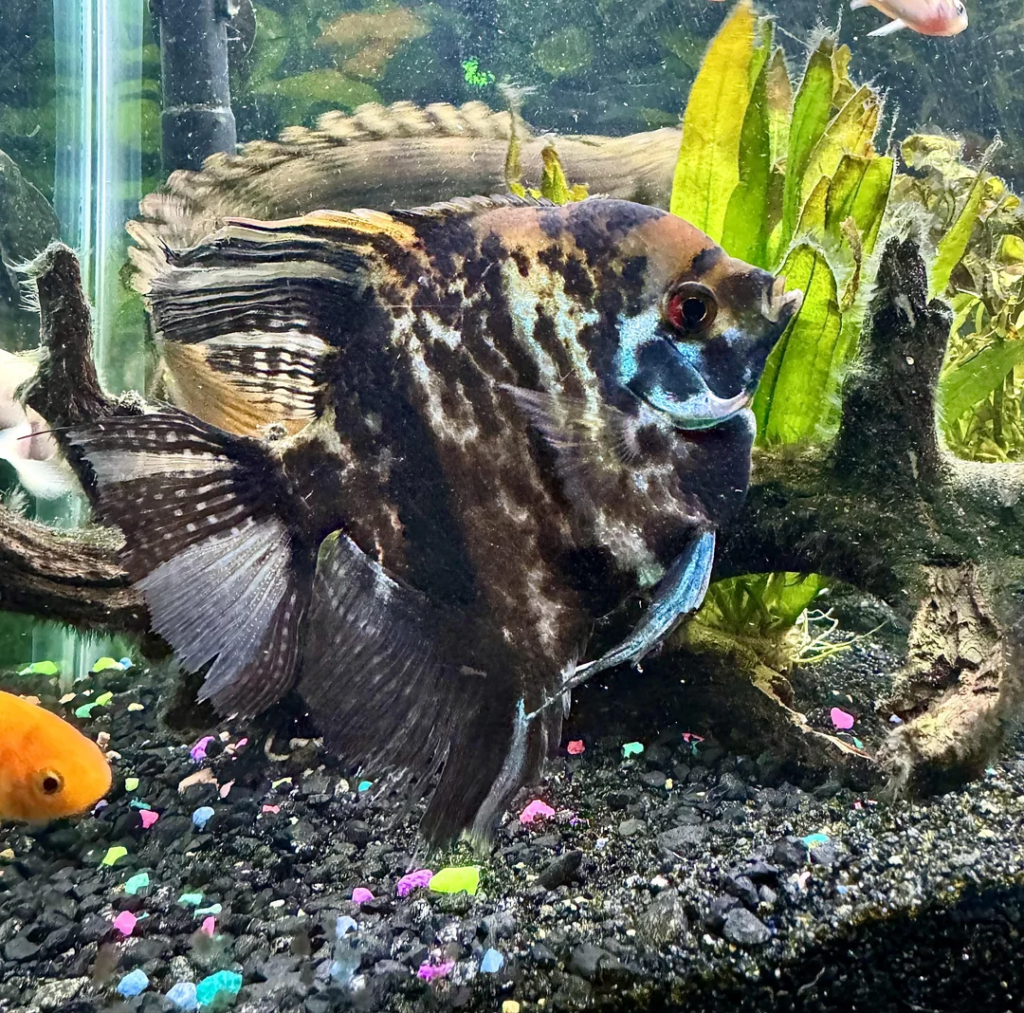
After choosing the right tank size and setting optimal water conditions, it’s time to complete your tank setup. Make your aquarium design for Angelfish as similar to its natural habitat as possible. It’ll help your fish’s psychology and physical growth to progress normally.
Substrates
Use soft substrates like sand, small pebbles, or granite because they’re gentle on your Angelfish’s body while beautifying your tank.
Decor
When setting up the aquatic decor for Marbled fish, find pieces that complement its patterned body. However, soft decor, like smooth plants, could be artificial or real. You can add smooth rocks and caves to create a hiding spot for them to mark as territory.
Filtration
After setting up your ideal tank conditions, you must maintain them because sudden changes can lead to stress and shock for your fish.
Ensure your water stays clean using a good filtration system to boost the nitrogen cycle and convert waste from harmful ammonia to useful nitrite nitrate. You can use a single canister filter for a 30-gallon tank and double canisters for the larger community tanks.
A combination of the care requirements and setup will give your Marble Angelfish the optimal tank environment to thrive.
What kinds of food can these pets eat for survival?
Feeding and Diet
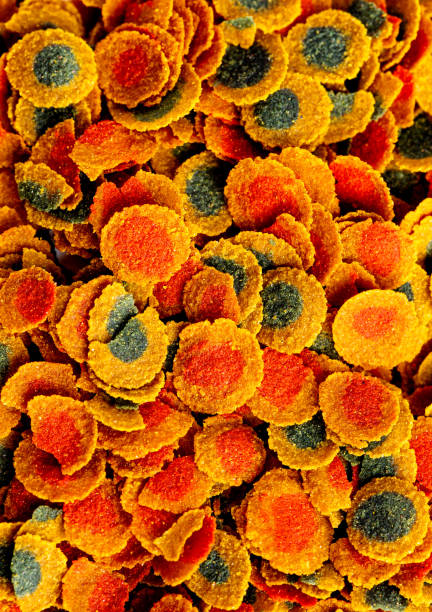
All kinds of food! Isn’t that fantastic? The Marble Angelfish diet doesn’t need too much thought. But that doesn’t mean you’re allowed to get lazy about feeding your pets because they still need a balanced diet.
You must feed your pets equal portions of live, frozen, freeze-dried, and plant-based meals because each one of them provides specific nutrition needs.
So, how can I identify nutritious fish food?
You can choose to sink commercial pellets or flakes made with all nutrients specifically for your Marble Angelfish, or take your time and prepare live and plant-based meals.
This species can eat brine shrimp, bloodworms, daphnia, and blanched vegetables for fiber and digestion.
For more on feeding your aquatic pets check out The Ultimate Guide to Fish Food: Pros and Cons & Best Choices!
As you feed your Marble Angelfish, monitor their feeding habits. Only feed the adults 2-3 times daily while the fry can have extra portions for a 4-times daily diet. Serve them portions they will finish in 2 – 3 minutes to avoid waste and overfeeding.
If they overfeed, they can have digestive problems or become overweight and pass on excess waste. They could also leave food uneaten, thereby causing water pollution.
Health and Common Diseases
Besides food-related illnesses, your Marble Angelfish can also get any of the common fish ailments. The good news is that there are steps for fish disease prevention, but you have to be proactive, and if that fails, there are treatments to save your pets.
Check them out:
White Spots
You’ll see a cottony, grainy white spot on your pet’s body caused by a parasitic infection. The first signs of white spots before you see the patches are itching and scratching against objects.
Treatment: Increase the water temperature to kill the parasite and use anti-parasitic creams on the Marble Angelfish’s affected area. You can also add anti-parasite treatment to the water to speed up the parasite’s life cycle.
For more details checkout our article on How to Treat Ich Outbreaks in Your Freshwater Fish!
Fin Rot
You’ll notice your Marble Angelfish’s normally elegant fins lose their color and start fraying at the edges. It’s often a result of poor water quality breeding bacteria that infect your pets.
Treatment: Change the water and maintain optimal conditions. Use Antibacterial treatments on the affected area.
Velvet
This is a form of discoloration that changes your vibrant Marble Angelfish appearance to a dusty or rusty tone. It’s a result of parasites and bacteria.
Treatment: Speed up the parasite’s life cycle by increasing the water temperature. Then, copper-based treatment was used on the affected area to restore the bright colors.
Columnaris
Mouth rot alongside frayed fins are the signs of Columnaris. It’s also a bacterial disease but more severe than fin rot.
Treatment: Change the water. Use antibiotic treatments.
Obesity
When your usually lateral-bodied Marble Angelfish starts getting too robust, it’s time to reduce the food portions. You’ll see them struggling to swim and getting lazier with social interaction.
Treatment: Fast your fish for two days or more, depending on the severity. Change their diet to a largely plant-based one rich in fiber for digestive health.
The best way to ensure Angelfish wellness is observation. If you watch your pets enough times, you’ll easily spot changes in behavior or physical traits, and then you can react early. However, I always recommend proactive aquatic health care as the best.
Breeding Process of Marble Angelfish

If you want more Marble Angelfish, their breeding process is simple. All you need for Angelfish reproduction is a quality breeding tank, healthy breeders, and fry-rearing tips. Luckily, you’re in the right place for answers.
Breeding Tank
It’s always best to use a separate breeding tank because the required temperature is slightly higher than a regular tank. But if you can’t afford a separate tank, you can use a divider to separate the breeding area from the living space.
Stabilize the temperature at 78 – 80℉ and keep the pH level slightly acidic at 6.5 – 7.5.
Add a spawning mop to a flat surface for the female to lay her eggs. The flat surface may be a wide leaf or a ceramic dish.
Breeding Fish
Observe your Marble Angelfish in groups as they form pairs so you can breed natural duos. But if they don’t pair themselves, you may step in and select the healthiest male and female.
This video has been very helpful in identifying the sex of angelfish, I highly recommend it:
The male will chase the female around the tank until she finds a hiding spot to lay her eggs after he nudges her belly. The male then fertilizes the eggs externally.
Fry-Rearing Tips
Within two to three days, your Marble Angelfish fry will hatch and feed on their yolk sac. By the fourth to sixth days, they’ll start free swimming and need infusoria to survive.
As they grow larger and develop mouths and teeth, you can add crushed flakes or pellets for fish fry to their diet. It’ll help their muscle and physical features develop.
Watch your fish fry as they grow and separate larger ones from the weaker ones to ensure they don’t prey on them. Then, reintegrate the fish into the main tank once it’s mature enough to survive with grown Marble Angelfish and other species.
That’s all it takes for successful fish breeding. Now, let’s focus on building a community tank.
Behavior and Compatibility
The Marble Angelfish’s behavior is naturally peaceful, which makes them ideal tank mates, but they can get aggressive in the face of competition. Whether they’re marking territories with spaces or food, this calm species would switch up its mood when it feels threatened.
So, to keep peaceful fish communities, you must ensure the tank mates are compatible. When testing for aquarium fish compatibility, hobbyists should consider the following:
- Temperament
- Feeding Habits
- Activity Level
- Size
Place only similar species in the same tank to avoid bullying and predation. To inspire your Marble Angelfish’s social behavior, pair them with Tetras, Rasboras, and Corydoras. But avoid putting them with fin-nippers like Barbs or small fish that can turn into food.
Conclusion
We’ve come to the end of another Angelfish appreciation post. I hope you’ve loved reading this Marble Angelfish care overview as much as I’ve enjoyed sharing it with you.
Please don’t forget all the fish-keeping tips shared in this guide. They’ll go a long way in guaranteeing you have a successful aquarium.
If you have any aquarium maintenance advice, please share it with our community, and if you have questions, feel free to ask. For now, it’s goodbye, but I can’t wait to see how you use this guide to expand the Marble Angelfish aquarium community!

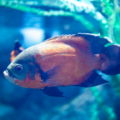




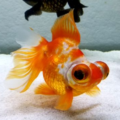


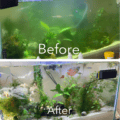

1 thought on “The Unique Charm of Marble Angelfish: A Detailed Guide ”